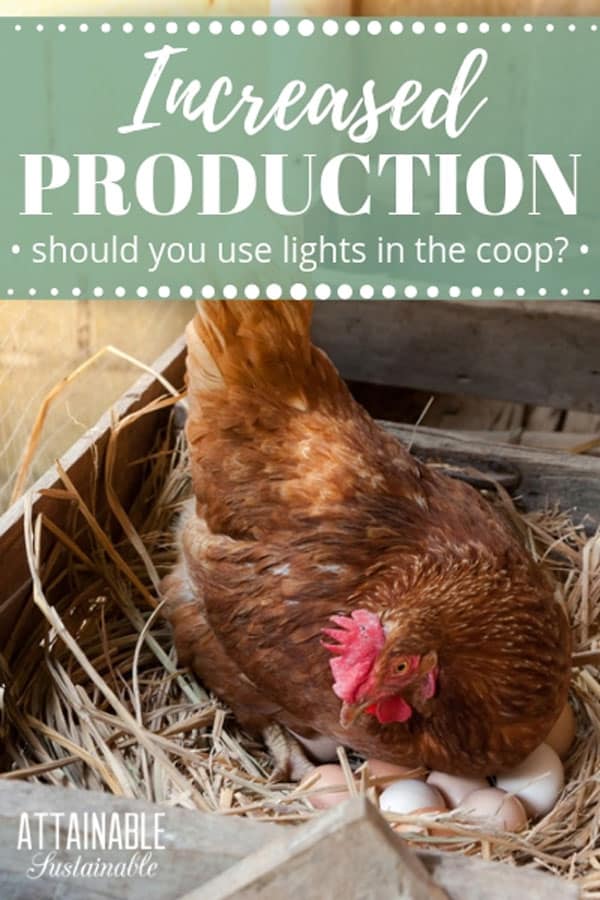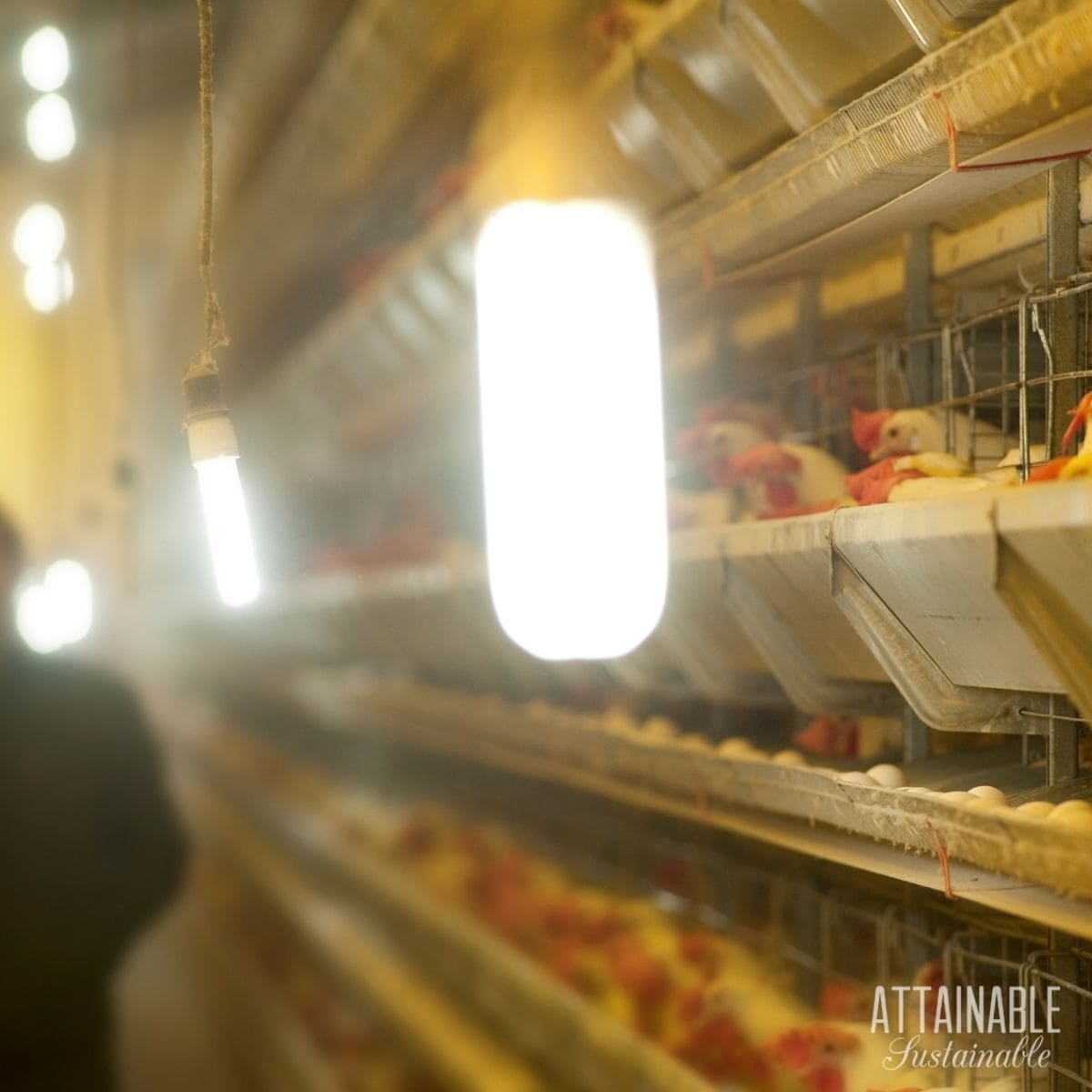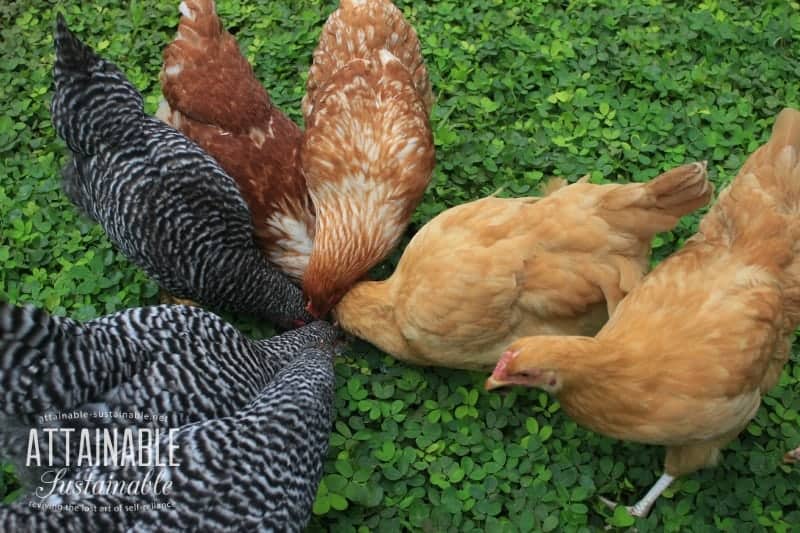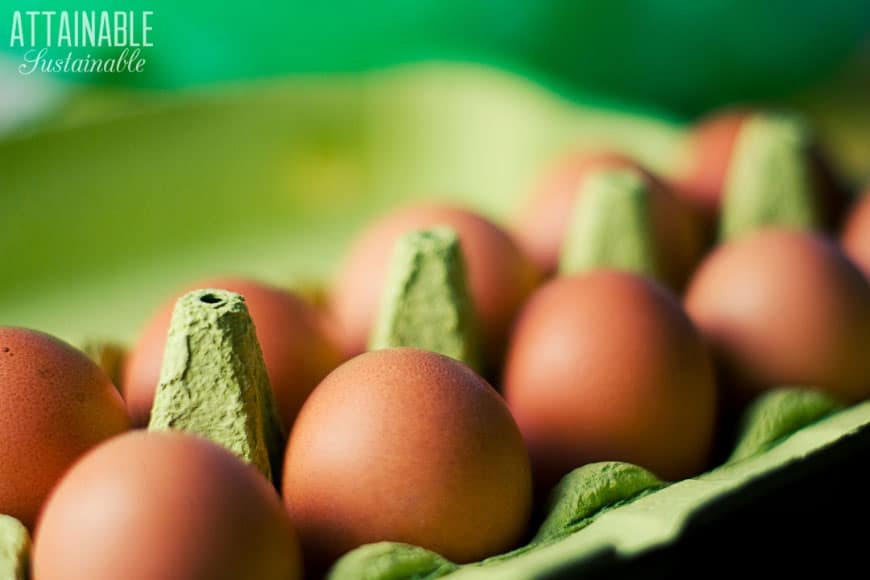During the winter months, a reduction in eggs is something you can expect from your hens. Is lighting the chicken coop in the winter the answer? Supplemental lighting for chickens can have some benefits, but only you can decide if chicken coop lights are something you’d like to install.
Originally contributed by Colleen Anderson in 2013; this post has been updated.
Have your chickens stopped laying eggs?
As most chicken owners know, with fall comes a slow down in egg production. Here’s why: Daylight stimulates the chicken’s pituitary gland which then stimulates the ovaries to make eggs.
A chicken needs 12-14 hours per day of light for maximum laying efficiency. So, shorter days and less sunlight means that your girls’ production levels go down. Sometimes they stop laying altogether. What’s a hungry chicken owner to do? Eat fewer eggs, I suppose.
Supplemental lighting for chickens
On the other hand, one solution that some chicken keepers (and most commercial egg producers) have come up with is to create an artificial environment with chicken lights (or supplemental lighting) in order to get more eggs by lighting their chicken coop in the winter months.
These chicken coop lights trick the chicken’s body into thinking it is still summer. (And honestly, it is really easy to trick a chicken’s body.)

Take a Peek Inside My Book!
Get a free excerpt from my book, Attainable Sustainable: The Lost Art of Self-Reliant Living! You’ll also get my free weekly newsletter, complete with recipes, gardening tips, and a little peek at what’s going on around here — both the zany and the mundane.
But do chickens need light at night?
Need? No. But supplemental lighting for chickens will almost certainly increase egg production through the winter. It’s how commercial egg facilities keep their hens laying regularly.
As with anything, there are many opinions on both sides of the chicken coop light debate. Here is a list of the pros and cons to providing supplemental lighting during the winter when raising chickens.
Pros:
- Increased egg production. What more can I say? The main reason to keep egg laying hens is to get eggs. If your chickens stopped laying eggs, then they are basically freeloaders.
- More eggs = more food and/or more money (if you sell your eggs). This reasoning alone is enough for a lot of people.
Cons:
- Chicken coop lights are not natural. Chickens are naturally meant to slow down on egg production in the winter. They are often coming off a molt and need to replenish their bodies and calcium stores. Many believe that forcing them to lay through winter will negatively affect their health, which seems entirely reasonable to me.
- Extended laying has been linked to higher chances of vent prolapse and ovarian cancer.
- Putting a light bulb, cords, and electricity in a coop poses a serious fire risk. Coops are generally made of wood and are covered in sawdust or other dry material, which burns easily.
- Energy usage increases when using supplemental lighting for chickens, thus egg costs and dependency on fossil fuels increase.
Related: Your Winter Duck Coop: Keeping Ducks in Cold Weather
Are your girls freeloading?
In my opinion, freeloader or not, chickens should get the winter off from laying (though they will definitely still lay some eggs, just not as many as they did in the summer). I try to raise my chickens as naturally as possible, which includes allowing them to follow their natural cycle, even in the winter.
If you think of eggs as a seasonal food (like any other “crop”), then it makes complete sense that you would take the highs with the lows and skip the supplemental chicken coop lights. I can certainly see why—practically speaking—people would want or need to get as many eggs as possible from their hens.
If you do add artificial lighting to your chicken coop in the winter, make sure your set-up is completely safe and well installed. You don’t want the supplemental lighting for chickens to turn into a chicken coop fire.
Related: Quail Eggs: The Perfect Solution for Urban Homesteaders
Ensure that you are feeding and supplementing your girls so that their bodies can keep up with the extra demands that extended laying puts on them. Additionally, consider the breed that you choose.
Pick a breed that is more cold tolerant and that is known for laying well in the winter months. At the end of the day, just make sure you are being as safe and treating your chickens as humanely as possible if you opt to light your chicken coop in the winter months.
Happy chickens = plentiful eggs. Good luck and happy chicken keeping!
If you’re raising poultry for eggs, you’ll want to know how to test to be sure eggs are still fresh.
Hints & Tips for Keeping Chickens in Your Backyard
- How to Grow Fodder for Chickens
- Make a Chicken Swing
- Feeding Chickens on a Budget
- Butchering Chickens
- Mistakes I Made in the Chicken Coop
- Put Your Backyard Chickens to Work in the Garden
- Grazing Boxes for Chickens
- Plant a Chicken Garden
- Do Your Hens Need Supplemental Light?
- Chicken Coop Supplies
- Controlling Mites
- Keeping Chickens Cool in Extreme Heat
- Build a Chicken Coop Extension from Pallets









I do both! Right now I let my hens stop laying and go thru molt as the days slowly shorten. Then after a couple of months with no eggs I turn on a light. I slowly increase the amount of time that it’s on until they start laying again. I figure that some areas of the world have a shorter winter than here in wisconsin. My girls still get a break, but I don’t have to wait 5 months without eggs. I care deeply for my chickens AND I need something from them. It’s been working for us
I do not think my chickens are free loaders even if they slow down im grateful to have them after all they feed us
I use an LED light. I have it on for 15 hours which provides them with 9 hours of darkness for sleep. I feel it is a good middle ground.
My father raises chickens. He chooses not to use a light or heat lamp due to the risk of getting the chickens used to it and then losing power, or the bulb burning out and the chickens freeze.
Those are good points!
I dont use supplemental light for my girls, I dont think its best for them. But there are plenty of other tactics you can use to help them lay all year round – this year in particular, I havent had an eggless period! https://bit.ly/1A8mLB1
I prefer not to use artifical lighting for my chooks, but there are plenty of other ways to approach extending their laying season – https://bit.ly/1A8mLB1
My hens have a heat lamp up in the peak of their roof that is on a temp timer. So if it gets too cold outside the heat lamp comes on and provides them with extra light too. They didn’t really start laying well until the beginning of fall, so I’m not expecting much in the winter. My question is how do you know which hens are laying and which ones are not? I have four hens and get 3 eggs.
Thank you for this post! We are feeling good about our decision not to light up our coop and give our girls a rest this winter.
I’m so glad to see you raise your chickens naturally. It seems to me the whole of Earth and all it’s creatures are meant to have “times and seasons”, including a “time of rest”. Time of rest allows for regeneration. For humans. For the planting ground. For everything. Whenever we force things to continue without allowing rest, it always seems to eventually lead to bad things. Everything should have a time of rest.
We add some extra light, and just installed a easy remote- https://littlehomesteadinboise.blogspot.com/2013/10/independence-days-lighting-coop.html Since we still have to feed the girls in the winter, we want some eggs, but don’t expect the normal amount…
I use a heat lamp with a red bulb in the coop to keep their water from freezing. It stays on 24/7. If I didn’t I would have to be out there twice a day changing their water in December and January. Last winter we had a full month of weather that was 0 degrees as the low. Does red light stimulate them the same way? I know I would hate to have the lights on in my bedroom all night. I was also told the red light disguises any bloody wounds on the hen-picked chicken and keeps the others from picking at that one even more. True? I was also told that they eat more when they are super cold, so keeping the coop a little warmer cuts down on feed cost when they aren’t earning their keep. I don’t baby my chickens by any means, but I do want to make sure they have humane living conditions.
I just wanted to share my terrible experience last winter with a red heat light. Even though I cleaned the coop regularly and “thought” I was keeping the dust levels down, apparently even doing so the dust that would regularly settle on the heat lamp eventually sparked and caused a fire. I lost my entire coop and all but 4 of my girls. It was a very traumatic event not only from the loss itself but also because my coop was very close to my home. I was outside in 12 inches of snow in my tank top and shorts pajama set crying and throwing snow at the fire waiting the few moments for the fire fighters to arrive. They were very quick but it was no use, the wood building, with the wood pine shaving floor combined with that heat was gone in a flash. I just wanted to share that in case you wanted to rethink your heat lights, they really do not need a heat source and there are other, safer methods I have found for keeping the water from freezing. Best wishes!
I have been raising my 5 girls in a natural environment. They are two years old have molted and gave us about 3 dozen eggs/week last summer. They slowed down in November to about 3-5 eggs/week – we were ok with that. In March they started laying again and we were back up to 2 doz/week. In April to now three of them quit laying completely and have been true freeloaders in every sense of the word. Have given them DE, wormed them, check them and the coop for mites, had them checked by the vet and the coop is cleaned weekly, they get plenty of sunshine and fresh air and are allowed to free range a portion of the day. Now we are in October and going into the cooler months and looking forward to no eggs again. I did try using a light, but they are being very stubborn. They get a good quality laying mash and fresh water all the time. Is there anything else I can do? or do I just live with freeloading chickens and no eggs?
the breeds we have are: Easter Egger – still laying like a champ, Welsummer – layed all last winter and has laid about 5 eggs total this summer, Black Australorp – no eggs since last November and goes broody about every 3 months or so, Buff Orpington – lays about 1 egg/week, Light Brahma – hasn’t laid since March but she is the boss